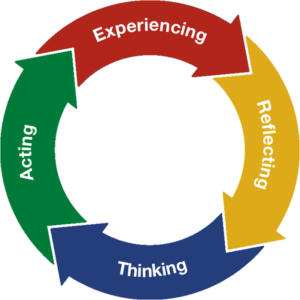Experiential learning
First, we need to know the definition of experiential learning, which my article defines as:” In its most simple form, experiential learning is constructing knowledge and meaning from real-life experience” (Yardley et al., 2012). More narrowly, experiential learning is learning through experience: “learning through reflection”. Hands-on learning can be a form of experiential learning, but it doesn’t necessarily require students to reflect on their products. There is a difference between experiential learning and rote learning.
We discussed three types of students: behavioralist, cognitivist, and constructivist. I want to point out that the experiential learning method works for cognitivist and constructivists. Cognitivist and constructivists learner would like to understand the knowledge.

In the article, the author states: “From Dewey onwards, experiential learning theorists have recognized that it is only through active engagement within the environment that learners can gain applied knowledge” (Yardley et al., 2012). In my last blog, I designed a virtual class trip which allows the student to study and discuss with classmates; that’s how the experiential learning process experience then steps to their conclusion.
In my group, our topic is Personal finance, and the target students are family dads/moms(some of them are colour-blind). experiential learning could work with those students. The first option is the stock market simulator, which is just for fun. Since stock could consider an investment, it belongs to our topic. However, the stock is placed at the last line of family finance (for family mom/dad). As a result, asking students to share how they manage their money, write a family budget planning report then comment on each other (like what we do) would be a great idea.
I do not consider experiential learning would be an excellent learning way for our topic. Compared with face-to-face courses, students will not have the same level of experience. After discussing with my group member, we decide to use Cooperative learning. so I read through some classmates and my group member’s blogs. I found that cooperative learning allows students to develop their creativity and initiative while breaking the teacher’s monopoly over classroom information. This is great because it motivates students to think and help each other. in addition, students communicate with each other to improve their relationship (find someone who is also colour blind, mom/dad) and mental health. this relationship also helps students willing to finish the course rather than drop it.
References:
What is experiential learning? Institute for Experiential Learning. (2021, October 22). Retrieved February 12, 2023, from https://experientiallearninginstitute.org/resources/what-is-experiential-learning/
Yardley, S., Teunissen, P. W., & Dornan, T. (2012). Experiential learning: Transforming theory into practice. Medical Teacher, 34(2), 161–164. https://doi.org/10.3109/0142159x.2012.643264
Hi Bruce! Thank you for sharing your thoughts on experiential learning! In fact, it would be really great if you could “design” a virtual stock simulator for your target audience to play with. This way, your students could apply knowledge and skills acquired from your lesson to real life in a safe manner without the risk of losing their money.
When using direct quotes, please add a specific page/paragraph the citation was taken, along with the author and year. You also used the image; what’s its source?
Hello Prof Anastassiya!
Thank you for your advice! I’m thinking of adding more detail to my blog!
Thank you for pointing out the image. I will fix this.